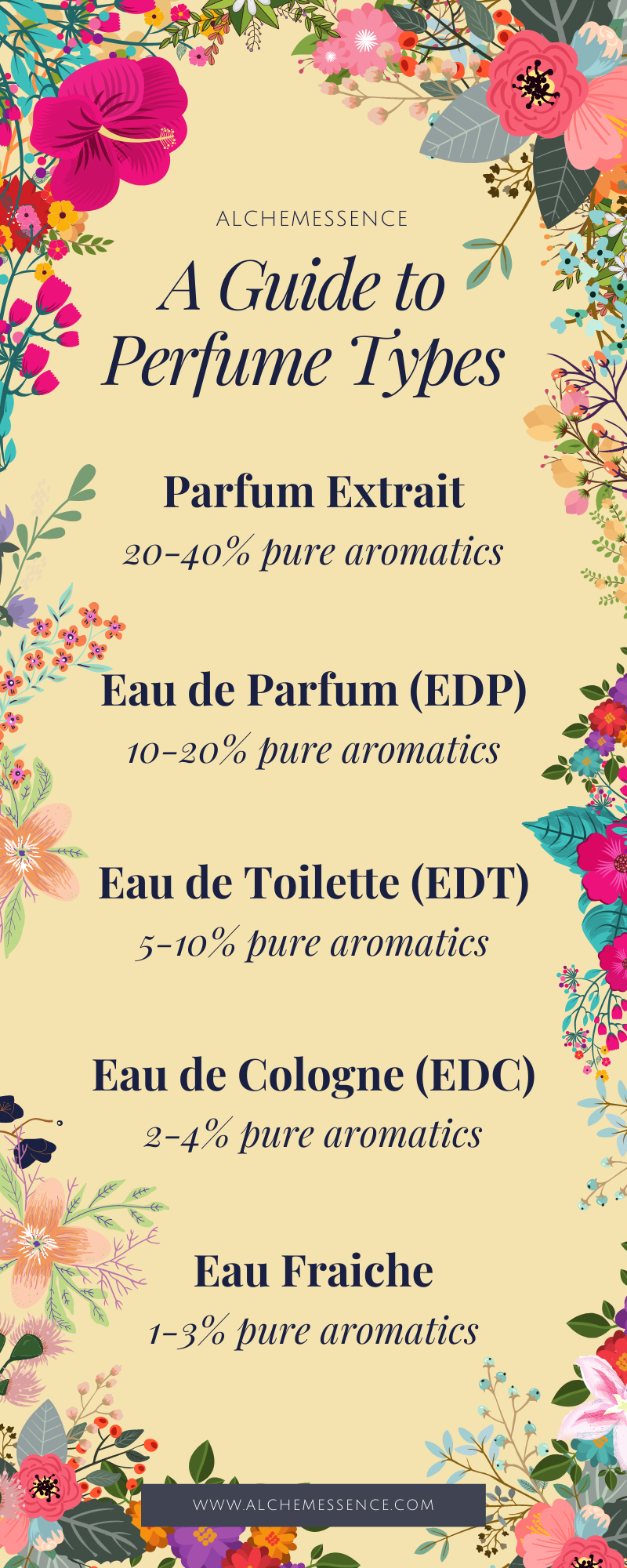A Guide to Perfume Types: Dilutions & Ratios in Natural Perfumes
EDP or EDT? Perfume or Parfum?
The world of fragrance is full of various terms that can be a bit confusing when you first hear of them — which is why I’ve put together this helpful guide :) Let’s take a look at the most common ratios, dilutions, and terms used in perfumery — and how they’re just a bit different when it comes to natural perfumes.
Psst! If you’re looking for info on natural perfume families — aka, chypre vs floral vs gourmand — you’ll want to take a look at this fascinating article: A Guide to Natural Perfume Fragrance Families.
What are perfume types?
In short, different strengths of perfumes have different names — this is what I mean by “perfume type”.
For example, an “eau de toilette” is usually at about a 10% dilution. This means that your fragrance will contain 10% fragrant material (either natural essences like essential oils, or chemical compounds in mainstream perfumes) and 90% carrier (usually alcohol or oil, and occasionally water).
Why is perfume type important?
Because the strength of your perfume dictates how long it will last. As you might guess, the stronger the dilution, the longer the wear and sillage…
Sillage—the aromatic trail left as someone wearing a perfume walks by
The most common perfume type is probably “eau de parfume”, often shortened to EDP. When people in the United States say “perfume”, this is usually what they mean.
If you look up perfume strength meanings online, you’ll find many lists with ratios similar to what I have here. These charts usually estimate the sillage by hour…
This doesn’t work with natural perfumes.
Natural perfumes don’t last as long as chemical-based ones — yet, if you’re just dipping your toes into the world of natural perfumery, you might be surprised at how long Alchemessence Perfumes do last. Here’s why:
Many people confuse botanical perfumes with aromatherapy blends. This is understandable — both are made with essential oils, and both can smell really good. But the two are actually extremely different. So much so that I’ll have an entire blog post dedicated to the topic soon…
What’s important now, is to understand that I intentionally design my botanical perfumes to last longer than simple aromatherapy blends, bringing together top and mid notes with long-lasting bases and “fixatives”.
Fixative—a botanical ingredient that extends the silage of your fragrance in natural perfumery
In natural perfumery, a fixative is a completely natural essential oil, absolute, or CO2 that extends the sillage of your perfume in a few different ways—by slowing down the evaporative rate or fortifying the fragrance, for example.
This means that some of my strongest perfumes will actually last up to 6hrs on your skin—naturally!
Decoding Dilutions: A Guide to Perfume Types and Concentrations
Of course, the more concentrated the perfume, the longer it will last. Here are the common types of perfumes based on their dilutions:
Parfum Extrait
Concentration: 20-40% perfume oil
Longevity: Lasts the longest, often for more than 6 hours, though the aroma of natural perfumes will change more during this window
Intensity: Highly potent and rich in scent
Application: Typically only a small amount is needed due to its strength
Characteristics: Expensive due to the high concentration of natural perfume oils, often packaged in smaller bottles, common in perfume oils and solids
Eau de Parfum (EDP)
Concentration: 10-20% perfume oil
Longevity: Lasts for around 3-6 hours depending on the ingredients
Intensity: Strong and noticeable, but slightly less potent than pure perfume
Application: Spritzing a couple of times on pulse points is usually sufficient
Characteristics: EDPs strike a balance between longevity and potency, making them popular choices and the most common perfume types
Eau de Toilette (EDT)
Concentration: 5-10% perfume oil
Longevity: Lasts for about 2 hours
Intensity: Lighter than EDP, suitable for a subtle scent
Application: Requires more spritzing throughout the day
Characteristics: EDTs are commonly used for everyday wear and are less overpowering
Eau de Cologne (EDC)
Concentration: 2-4% perfume oil
Longevity: Lasts for about 1-2 hours or less
Intensity: Very light and refreshing
Application: Needs frequent reapplication due to its low concentration
Characteristics: Often used for a quick refreshment or in warmer weather due to its light nature
Eau Fraiche
Concentration: 1-3% perfume oil
Longevity: A brief aromatic experience
Intensity: Extremely light and subtle
Application: Requires frequent reapplication
Characteristics: Eau Fraiche has the lowest concentration of perfume oils and is mostly used for a quick mood boost
It's important to note that the longevity and intensity of a fragrance also depend on individual skin chemistry and the specific ingredients in the perfume. Additionally, the same fragrance may smell slightly different at various concentrations due to the interactions between the perfume oils and the other components of the fragrance.
When choosing a perfume, consider your personal preference for intensity, how long you want the scent to last, and the occasion for which you're wearing it. It's a good idea to test perfumes on your skin to see how they interact with your body chemistry and to experience how they develop over time. Natural perfumes especially tend to be shape shifters, dancing uniquely with each of our personal chemistries.
Find your personal, all-natural fragrance in the Alchemessence Perfumery.
Share this article on your favorite platform — and give it a heart to let me know you like it!
